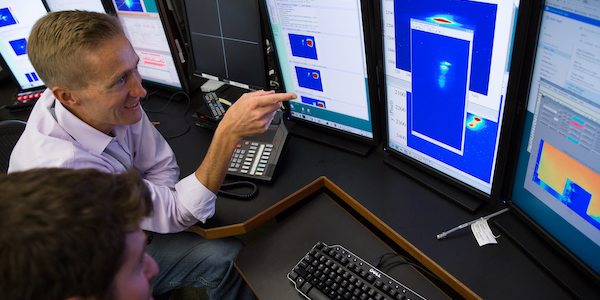Resources
Resources
Intro to Laser Scientist Jobs–What Can You Do with a PhD in Laser Science?
Jan 17, 2025. Blog

Two researchers sit in the master control room of the Facility for Advanced Accelerator Experimental Tests (FACET).
Photo credit: SLAC National Accelerator Laboratory.
Interest in lasers is flourishing! Lasers have countless applications, inspiring scientists and driving innovations for more than half a century. While not every passion can become a career, for those who love lasers, several types of laser scientist jobs have expanded into the market, and one might be the right fit for you.
The salary range for laser scientists can vary because of numerous employment opportunities and postings across many industries and locations. With this in mind, it’s safe to say that laser scientists can earn up to well over $100K annually. Read on for a high-level overview of some of the most sought-after openings in laser science.
Laser Research Scientist
Although a research scientist position may seem like the most obvious role for someone in the laser science field, it is not the most common occupation in that domain. Take, for instance, manufacturing engineer jobs, which are plentiful since they are required in nearly every facility that uses lasers in manufacturing. In contrast, laser scientists typically work at a research facility or institute. This means the pool of openings for laser research scientists is generally smaller; however, their work is often more specialized.
Research scientists conduct fundamental research in physics, optics, and photonics, which enables them to help shape the future of laser science.
Laser research scientists’ responsibilities involve developing new laser systems and applications and publishing their research findings in scientific journals. They may also mentor junior team members or students on research projects. This role is ideal for individuals fascinated with lasers and laser-related tech.
Optical Physicist
Optical physicists are indispensable in developing laser systems and devising solutions to commonplace technological challenges. They use mathematical models and simulations to predict and optimize the behavior of optical systems. Their expertise is critical as lasers rely extensively on optical components to function.
The efforts of these scientists, who conduct experimental research, test new concepts, and validate theoretical models, are crucial for enhancing and improving existing laser designs. Their work delves into pioneering material research and leveraging modern materials to push boundaries. This intrinsic aspect of the optical physicist’s duties is a driving force in the ongoing evolution of lasers.
Laser Application Scientist
We’ve discussed scientists working on improving lasers, but what are these lasers used for? A laser application scientist will help define that.
The role of a laser application scientist involves inventing new ways to use lasers and forging new industries where they are applied. They are also charged with determining how to use lasers more effectively in their current applications, making the laser application scientist one of the most relevant careers in laser science.
Laser research relies on collaborative science, where specialists in various applications work together to further scientific efforts. A laser application scientist collaborates with engineers, experts in assorted fields, and research scientists, all working behind the scenes to heighten the benefits lasers bring to our world.
Biomedical Optics Researcher
With an optics and/or photonics degree, you can pursue a career as a biomedical optics researcher. Biomedical optics researchers play a vital role in saving lives, and they hold one of the optic laser scientist jobs that can offer the most significant opportunity to advance science.
These professionals use technology principles such as optical coherence tomography (OCT) and multiphoton microscopy to improve the accuracy and conclusiveness of the imaging doctors use today. OCT is not the only imaging technology available through laser application that a biomedical optics researcher might use. In fact, they may use fluorescence imaging to help study biomolecules of cellular structure, resulting in a far better understanding of certain diseases.
Interaction with laser light can have a therapeutic effect on biological tissues, so biomedical optics researchers are essential in exploring this concept in wound healing, pain management, and tissue regeneration.
Manufacturing Engineer
While laser technology is undoubtedly cool and innovative, it must also be cost-effective to apply it properly in manufacturing. A manufacturing engineer is responsible for streamlining manufacturing processes that incorporate laser technology.
Tasks can involve design processing, quality control, automation and robotics, and integrating systems. The manufacturing engineer would also work closely with the R&D department. Most importantly, the position is accountable for cost analysis, requiring an executive mindset.
Though this might differ from what an average laser enthusiast has in mind when researching how to become a laser scientist, this type of position pays well and is in demand across many industries. Almost every factory that plans to incorporate lasers needs a manufacturing engineer.
Wrap up
The roster of laser scientist jobs goes on and on, ranging from photonics engineers and laser safety officers to professors in academic institutions. We’ve listed a few here to get you started on exploring the options that best fit your goals and preferred workplace dynamics.
Keep in mind that advances in laser science continue expanding positions in the job market, which makes the field diverse enough to allow for pivoting later in your career if you seek even newer, more laser-focused horizons.
If you’re interested in discovering the world of laser science, explore career options and insights with LaserNetUS today!
More From Blog